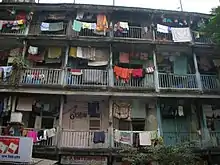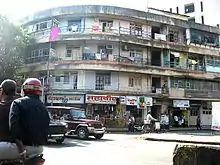Chawl
A chawl (Marathi:चाळ) is a type of residential building found in western India, similar to a tenement. Typically low quality housing, chawls are generally associated with poverty. The first chawls were constructed in the early 1700s, as housing for industrial workers.[1]


History
Chawls are rooted in the history of Bombay's (now Mumbai) colonial past. Workers migrated to Bombay from far and wide, as it was the center of trade for the East India Company. However, due to the land being unequally divided, British merchants and officials lived in sprawling bungalows, leaving little space for the working class. To accommodate this workforce, Chawls sprung up. These were tiny one room apartments shared by up to five people. Being highly congested, unsanitary, and unsafe, these were also more expensive than comparable accommodation in other Indian cities.[2]
Town planning in Bombay finally came about due to fears of a plague epidemic, due to which The City Of Bombay Improvement Trust was established in 1898. Initial projects failed, displacing far more than they resettled. However, subsequent projects saw greater success, which largely included land reclamation projects to connect the Seven Islands of Bombay. This, along with modern apartments, led to availability of better housing, due to which chawls have declined. However, they may still be seen in the poorer parts of Mumbai.[3]
Description
Building layout
Chawls are typically 4 to 5 stories tall, with between 8 and 16 dwellings on each floor. These dwellings are known as kholis. A central staircase services the building and gives access to a long passage which runs the length of each floor. Many chawls are also built around a small courtyard, which functions as a communal space for residents.[4] As many chawls are made with wood and often not subject to repairs, they become unstable or unsafe to live in over time, sometimes requiring relocation of the residents for fear that the structure may collapse.[5][6]
Sanitation
Families on a floor have to share a common block of latrines. Tenements with private bathrooms are highly sought after and may be 50% more expensive than the price of a normal chawl.[7] The lack of bathrooms has been credited with furthering disease outbreaks in chawls.[8] Infestations of insects such as cockroaches or centipedes are not uncommon either, and with no rules about littering, sanitary conditions are usually very poor.[9][10]
Life for residents
Despite poor sanitation and living conditions, chawls are often seen as "middle class" housing, and are often more affordable than much of the housing in Mumbai.[11] Some chawls have shops or businesses incorporated into their structure, which provide employment or shopping opportunities to the inhabitants.[12]
Residents of chawls sometimes cite a sense of community where everything is shared amongst themselves; the cramped design of chawls forces social interaction between residents and very often special occasions such as weddings or religious festivals are celebrated communally.[13][14][15]
In popular culture
In Mulk Raj Anand's novel Coolie, the central character Munoo lives with two family groups in a chawl during his time in Bombay with detailed descriptions of the living circumstances. The 2019 Marathi-language drama film, 15 August (Marathi: १५ ऑगस्ट) revolves around life in a chawl, with the majority of the filming taking place there.[16] In Kiran Nagarkar's novel Ravan & Eddie, both main characters and their families live in a chawl.[17]
Chawls are featured in a Mumbai level in the game Hitman 2.[18]
See also
- Cortiço – a term used in Brazil and Portugal for an area of concentrated, high density urban housing, Cortiço houses are typically divided into small rooms that are rented.
- Casa di ringhiera a very similar type of housing built in the same period, and for the same purposes in Northern Italy.
- Corrala, casa de corredor, or edificación de vecindad, a similar structure typical of Madrid, but also found in some other towns in Castile, as well as in parts of Andalusia and some other cities in Spain.
- Corral de comedias, this same structure used as a venue for theater, especially in Madrid during the Spanish Golden Age.
References
- "Physical and Social Configurations of the Bombay Chawls". Sahapedia. Retrieved 3 April 2021.
- National Council of Educational Research and Training, NCERT. India and the Contemporary World, part II (PDF). NCERT. p. 142,143.
- National Council of Educational Research and Training, NCERT. India and the Contemporary World, part II (PDF). NCERT. p. 144,145.
- Kamath, Naresh. "There's room for everyone: How Mumbai's chawls have been housing people for 117 years". Hindustan Times. Retrieved 22 August 2019.
- "Thereby Hangs A Storey | Outlook India Magazine". magazine.outlookindia.com/. Retrieved 3 April 2021.
- "Chawl caves in at Mumbai suburbs". Deccan Herald. 10 May 2020. Retrieved 3 April 2021.
- Kamath, Naresh. "There's room for everyone: How Mumbai's chawls have been housing people for 117 years". Hindustan Times. Retrieved 22 August 2019.
- Yadavar, Swagata (17 May 2020). "6 toilets for 20 houses, inadequate testing: Why Mumbai's Worli chawls are a Covid hotspot". ThePrint. Retrieved 3 April 2021.
- Homegrown. "What It's Actually Like To Live In A Mumbai Chawl". homegrown.co.in. Retrieved 3 April 2021.
- Contributor, Quora (25 June 2013). "India: What Is It Like to Live in a Chawl?". Slate Magazine. Retrieved 3 April 2021.
{{cite web}}:|last=has generic name (help) - Sriram, Jayant (7 March 2016). "What chawls can teach us". The Hindu. ISSN 0971-751X. Retrieved 3 April 2021.
- Karandikar, P., 2010. Chawls: Analysis of a middle class housing type in Mumbai, India. Iowa State University.
- "A life in the day of the chawl". DNA India. 16 September 2006. Retrieved 3 April 2021.
- "Jeetendra recalls memories of growing up in a chawl, says neighbours gathered at his home to see a ceiling fan. Watch". Hindustan Times. 13 March 2021. Retrieved 3 April 2021.
- "Learning from the Chawl Culture – Architecture & more by Square One". Retrieved 3 April 2021.
- Jaykar, Swapnaneel (29 March 2019), 15 August (Drama), Abhishek Deshmukh, Mrunmayee Deshpande, Namrata Kadam, Addinath Kothare, RnM Motion Pictures, retrieved 3 April 2021
- Ravan and Eddie. 11 December 2012. Retrieved 3 April 2021 – via www.amazon.com.
- Mumbai - The Dubious Cohabitation - Hitman Wiki Guide - IGN, retrieved 3 April 2021
Further reading
- Karandikar, Priyanka (2010). Chawls: Analysis of a middle class housing type in Mumbai, India (MS thesis). Iowa State University. Retrieved 31 January 2013.
- Sanyal, Tithi (2018). The Chawls and Slums of Mumbai (PDF) (MS thesis).
External links
- Times of India Life in a chawl. 6 February 2011.
- Slate (magazine)/Quora What Is It Like to Live in a Chawl? First person description of growing up in a chawl. 25 June 2013.